We may not have the course you’re looking for. If you enquire or give us a call on +352 8002-6867 and speak to our training experts, we may still be able to help with your training requirements.
Training Outcomes Within Your Budget!
We ensure quality, budget-alignment, and timely delivery by our expert instructors.

Picture a massive library where every book has lost its unique code. Chaos, right? That's exactly what databases would look like without Candidate Key in DBMS. They're like digital fingerprints, ensuring every piece of data has its own identity in the vast ocean of information. But what exactly is a Candidate Key, and how does it help preserve the integrity of the database?
In this blog, we’ll explore the Candidate Key in DBMS, its properties, and how it contributes to the overall structure and efficiency of Database Management. Keep reading to discover how these keys ensure smooth Data Management while preventing redundancy.
Table of Contents
1) What is Candidate Key in DBMS?
2) Different Types of Candidate Keys
3) Properties of Candidate Keys
4) Methods for Identifying Candidate Keys
5) Examples of Candidate Keys
6) Candidate Key vs Primary Key
7) Candidate Key vs Super Key
8) Conclusion
What is Candidate Key in DBMS?
A Candidate Key in a Database Management System (DBMS) is essential for uniquely identifying records in a table. It ensures data integrity and efficient retrieval by meeting two key criteria:
a) Uniqueness (each value is distinct)
b) Minimal redundancy (no subset of the key can uniquely identify a record)
During database design, one Candidate Key is selected as the primary key, which serves as the central reference for relationships with other tables. This choice aids in database normalisation, reducing redundancy and dependencies. Overall, the Candidate Key plays a crucial role in maintaining a well-structured and reliable relational database system.
Different Types of Candidate Keys
In database design, several types of Candidate Keys can uniquely identify records within a table. These include:
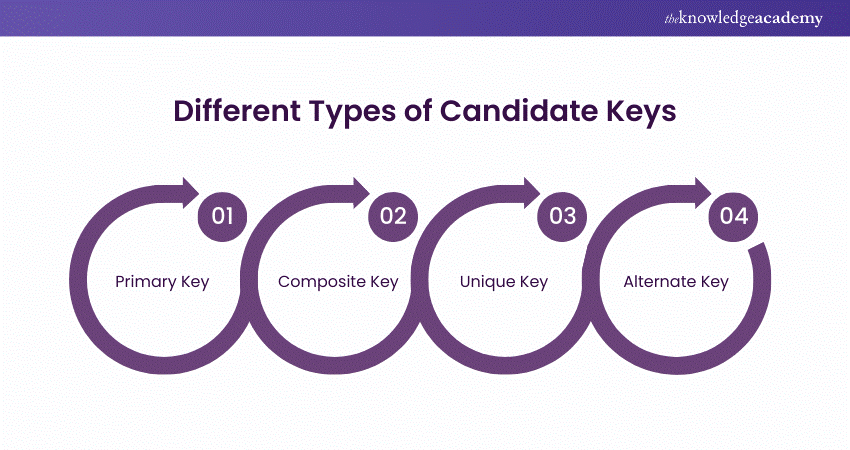
1) Primary Key
a) Uniquely identifies each record in a table.
b) It must be unique and non-null.
c) Only one primary key is allowed per table.
d) Ensures data integrity and facilitates efficient data retrieval and indexing.
e) Essential for establishing relationships between tables.
2) Composite Key
a) Comprises multiple columns that together form a unique identifier.
b) Individual columns may not be unique, but their combination must be.
c) Useful when no single column can uniquely identify records.
d) Commonly used in many-to-many relationship tables and bridge tables.
3) Unique Key
a) Guarantees uniqueness in a table, similar to a primary key.
b) Multiple unique keys are allowed per table.
c) It can contain a single NULL value.
d) Valuable for maintaining data integrity and supporting efficient indexing and relationships.
4) Alternate Key
a) A Candidate Key is not chosen as the primary key.
b) Serves as an additional unique identifier for records.
c) Offers additional querying and data organisation options.
d) Contributes significantly to the development of table relationships.
Master Redis Cluster Database skills and boost your Data Management efficiency with our Redis Cluster Database Training today!
Properties of Candidate Keys
Candidate Keys are characterised by specific properties, which are essential to maintaining their role in databases:
1) Uniqueness
a) Each Candidate Key must uniquely identify every record in the table.
b) No two records can share the same key value.
c) Ensures precise identification of records.
d) Example: A passport number uniquely identifies each individual.
2) Minimality
a) A Candidate Key contains only the essential attributes needed for uniqueness.
b) Removing any attribute would break its uniqueness.
c) No redundant attributes are permitted.
d) Example: If StudentID is unique, the combination {StudentID, Email} is not minimal.
3) Non-null
a) Candidate Keys cannot contain null values.
b) Every attribute within the key must have a value.
c) This is essential to preserve uniqueness.
d) Example: An Employee ID must always have a value and cannot be left empty.
4) Immutability
a) The values of Candidate Keys should not change over time.
b) Stability ensures consistent record identification and maintains referential integrity.
c) Example: Social Security Numbers (SSN) are immutable, while contact details like phone numbers can change.
Methods for Identifying Candidate Keys
There are a few methods commonly employed to identify Candidate Keys within a table:
1) Functional Dependency Analysis: Analyse functional dependencies within a table to determine the minimal set of attributes that can serve as a Candidate Key.
2) Decomposition: In cases of composite keys, break down the set of attributes to its smallest form where the irreducibility property holds true.
3) Trial and Error: Sometimes, experimenting with different combinations of attributes helps identify the most suitable Candidate Key for a particular dataset.
Master GraphQL Database Training With React Course for seamless database integration and efficient data handling!
Examples of Candidate Keys
Here are the examples of Candidate Keys:
Example 1: Employee Table
In an employee table, the following could be considered as Candidate Keys:
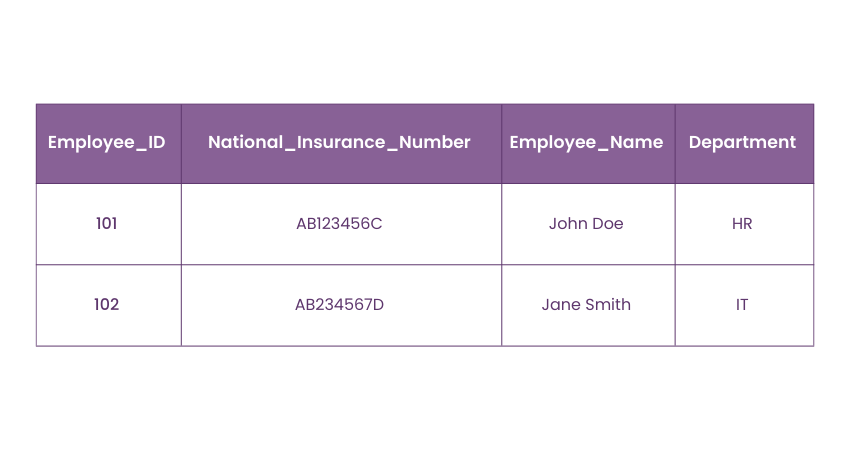
In this table, both the Employee_ID and National_Insurance_Number can serve as Candidate Keys since both attributes uniquely identify each employee.
Example 2: Product Table
Consider a product table:
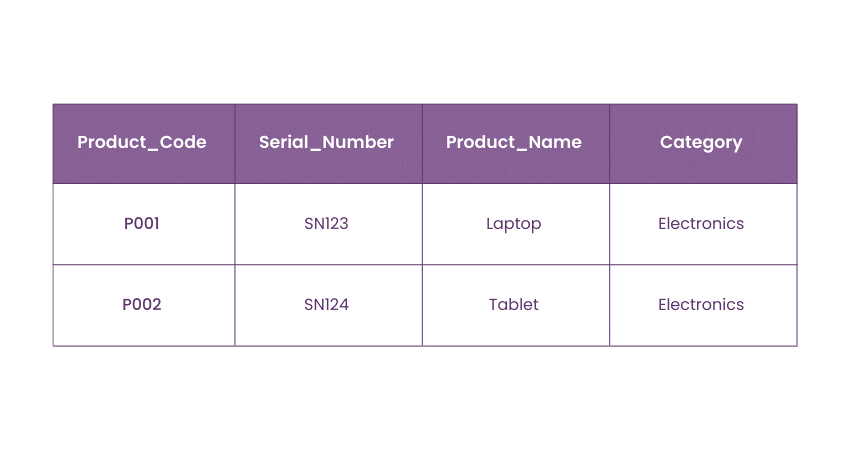
Here, both Product_Code and Serial_Number are Candidate Keys since they can each uniquely identify a product in the table.
Candidate Key vs Primary Key
Here’s a difference between Candidate Key and Primary Key:
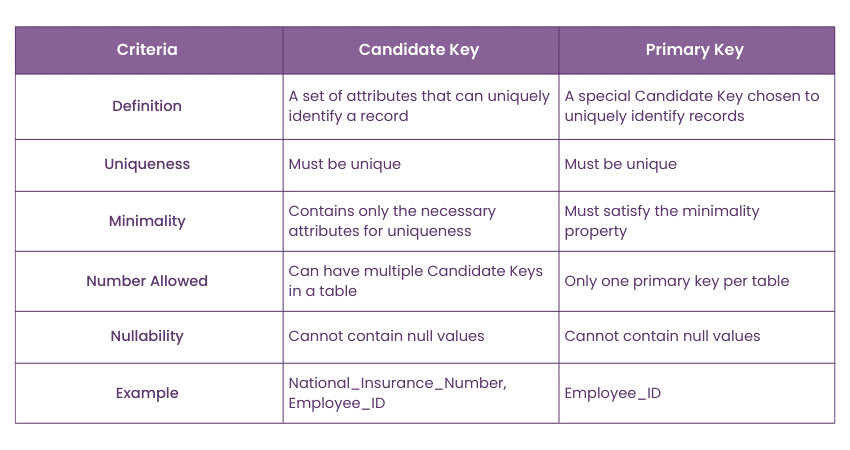
Candidate Key vs Super Key
Here’s a difference between Candidate Key and Super Key:
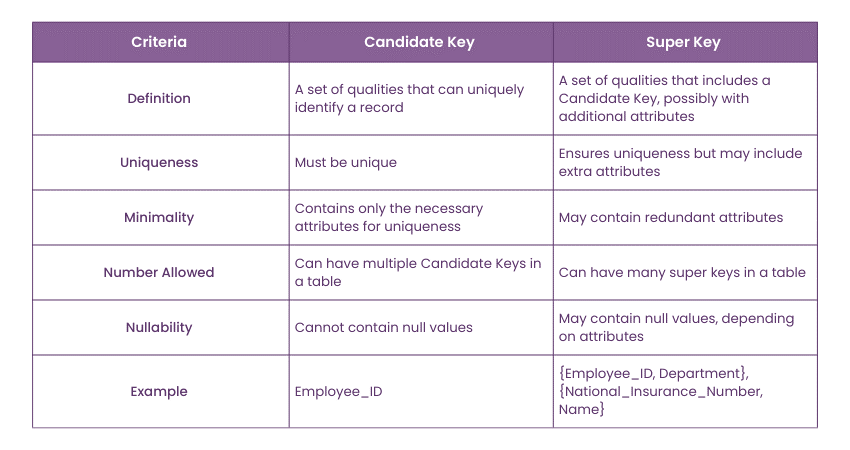
Learn essential Relational Databases & Data Modelling Training and strengthen your expertise in relational databases today!
Conclusion
The Candidate Key in DBMS is the key to maintaining an organised and efficient database, ensuring every record stands out uniquely. By preventing redundancy and preserving data integrity, it keeps everything running smoothly. Without it, the database would quickly become a tangled mess!
Elevate your database skills with expert Database Training and unlock limitless career opportunities!
Frequently Asked Questions

No, Candidate Keys cannot contain null values. Each attribute in a Candidate Key must have a valid, non-null value to ensure the uniqueness and proper identification of records within a table.

Yes, a table can have more than one Candidate Key in DBMS. These Candidate Keys serve as potential unique identifiers for records, but only one is selected as the primary key.

The Knowledge Academy takes global learning to new heights, offering over 30,000 online courses across 490+ locations in 220 countries. This expansive reach ensures accessibility and convenience for learners worldwide.
Alongside our diverse Online Course Catalogue, encompassing 19 major categories, we go the extra mile by providing a plethora of free educational Online Resources like News updates, Blogs, videos, webinars, and interview questions. Tailoring learning experiences further, professionals can maximise value with customisable Course Bundles of TKA.

The Knowledge Academy’s Knowledge Pass, a prepaid voucher, adds another layer of flexibility, allowing course bookings over a 12-month period. Join us on a journey where education knows no bounds.

The Knowledge Academy offers various Database Training, including Introduction To Database Training, Relational Databases & Data Modelling Training and GraphQL Database Training With React. These courses cater to different skill levels, providing comprehensive insights into Deadlock in DBMS.
Our Programming & DevOps Blogs cover a range of topics related to DBMS, offering valuable resources, best practices, and industry insights. Whether you are a beginner or looking to advance your Programming and DevOps skills, The Knowledge Academy's diverse courses and informative blogs have got you covered.
Upcoming Programming & DevOps Resources Batches & Dates
Date
 Introduction to Database Training
Introduction to Database Training
Fri 21st Feb 2025
Fri 25th Apr 2025
Fri 20th Jun 2025
Fri 22nd Aug 2025
Fri 17th Oct 2025
Fri 19th Dec 2025







 Top Rated Course
Top Rated Course



 If you wish to make any changes to your course, please
If you wish to make any changes to your course, please


